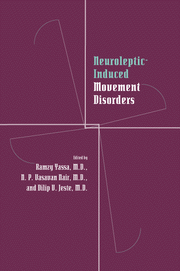Book contents
- Frontmatter
- Contents
- Contributors
- Preface
- Part I Historical perspective
- Part II Clinical aspects of tardive dyskinesia
- Part III Mechanisms underlying tardive dyskinesia
- 11 Neurochemistry of the basal ganglia
- 12 A reanalysis of the dopamine theory of tardive dyskinesia: the hypothesis of dopamine D1/D2 imbalance
- 13 Tardive dyskinesia and phenylalanine metabolism: risk-factor studies
- 14 Neuroendocrinological studies of tardive dyskinesia
- 15 Cognitive deficits and tardive dyskinesia
- 16 Studies of tardive dyskinesia using computed tomography and magnetic-resonance imaging
- 17 Rodent and other animal models of tardive dyskinesia during long-term neuroleptic-drug administration: controversies and implications for the clinical syndrome
- Part IV Measurement of tardive dyskinesia
- Part V Tardive dyskinesia in different populations
- Part VI Other neuroleptic-induced movement disorders
- Part VII Treatment of tardive dyskinesia
- Index
15 - Cognitive deficits and tardive dyskinesia
from Part III - Mechanisms underlying tardive dyskinesia
Published online by Cambridge University Press: 09 October 2009
- Frontmatter
- Contents
- Contributors
- Preface
- Part I Historical perspective
- Part II Clinical aspects of tardive dyskinesia
- Part III Mechanisms underlying tardive dyskinesia
- 11 Neurochemistry of the basal ganglia
- 12 A reanalysis of the dopamine theory of tardive dyskinesia: the hypothesis of dopamine D1/D2 imbalance
- 13 Tardive dyskinesia and phenylalanine metabolism: risk-factor studies
- 14 Neuroendocrinological studies of tardive dyskinesia
- 15 Cognitive deficits and tardive dyskinesia
- 16 Studies of tardive dyskinesia using computed tomography and magnetic-resonance imaging
- 17 Rodent and other animal models of tardive dyskinesia during long-term neuroleptic-drug administration: controversies and implications for the clinical syndrome
- Part IV Measurement of tardive dyskinesia
- Part V Tardive dyskinesia in different populations
- Part VI Other neuroleptic-induced movement disorders
- Part VII Treatment of tardive dyskinesia
- Index
Summary
An understanding of the multifaceted neurological disorder known as tardive dyskinesia, including its association with cognitive deficits, requires a global conceptualization. In this context, we must view tardive dyskinesia as an illness, the etiology of which follows the well-established biological scheme of a host (having various degrees of predisposing factors), a noxious agent (the neuroleptic drug), and an environment in which the first two components interact. Although studies abound concerning the roles of vulnerability factors, as well as antipsychotic agents, in the development of tardive dyskinesia (Kane & Smith, 1982; Singh & Simpson, 1988), research on environmental factors is scarce. Thus, before turning to our main review, we shall first briefly examine two sociological studies: one conducted in an inpatient setting, the other in an outpatient setting.
Two Sociological Studies
In the inpatient setting, it was the nursing staff who initially resisted our attempts to implement the recommendations of the American Psychiatric Association (1979) task-force report on the late neurological effects of antipsychotic drugs. The nurses were opposed to instituting the APA's suggested drug-free periods for patients on long-term neuroleptic treatment. We conducted many extra meetings and workshops to convince staff personnel on all shifts that such intervention was medically sound, safe, and feasible. But the nurses feared, even expected, that patients would experience clinical decompensation, and in the beginning they tended to consider any change in a patient's behavior during drug discontinuation to be indicative of deterioration.
- Type
- Chapter
- Information
- Neuroleptic-induced Movement DisordersA Comprehensive Survey, pp. 196 - 206Publisher: Cambridge University PressPrint publication year: 1996



